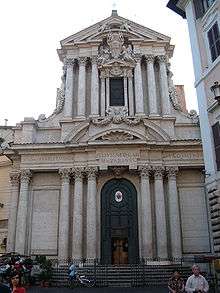Bulgarians in Italy
The Bulgarians in Italy are one of the sizable communities of the Bulgarian diaspora in Western Europe. There are about 120,000 Bulgarians in Italy according to the Bulgarian government.[1] There are Bulgarian Orthodox parishes in Rome and Milan.[2] Major centres of Bulgarian migration are Milan, Bologna, Florence and Torino.

| Part of a series on |
| Bulgarians Българи |
|---|
 |
| Culture |
|
| By country |
| Subgroups |
| Religion |
|
| Language |
|
| Other |
|
History
In the early 7th century AD, groups of Bulgars, one of the ancient peoples that participated in the ethnogenesis of the modern Bulgarians, settled in the Italian Peninsula. The main migration was headed by Altsek, a Bulgar leader who initially joined the Avar Khaganate before switching allegiance to the Germanic Lombards. Altsek and his people arrived in the Exarchate of Ravenna, where Grimoald I of Benevento invited them to populate the Duchy of Benevento. According to the Gesta Dagoberti I regis Francorum, Altsek's Bulgars settled in what are today the communes of Isernia, Bojano and Sepino. Altsek remained the leader of the Bulgar-populated areas, bearing the title gastald.[3][4][5][6]
It is uncertain whether this Altsek can be identified with another Bulgar lord, Altsiok. According to the Chronicle of Fredegar, Altsiok deserted the Avar Khaganate in 631–632. Altsiok settled in Bavaria with 9,000 Bulgars under Frankish king Dagobert I. Altsiok is known to have moved to the Venetian March with his 700 remaining men after Dagobert I slaughtered most of his people.[3][4][5]
Paul the Deacon in his Historia Langobardorum writing after the year 787 says that in his time Bulgars still inhabited the area, and that even though they speak "Latin," "they have not forsaken the use of their own tongue."[7] In later times they had evidently become completely assimilated.
Human graves of a steppe nomadic character as well as horse burials dated to the second half of the 8th century AD attest to the presence of Bulgars in the Molise and Campania regions.[8] Toponyms containing the root bulgar and personal names such as Bulgari and di Bulgari continued to appear in medieval documents relating to the Italian Peninsula.
In the 17th century, Bulgarian Roman Catholics often visited Rome in their attempts to negotiate support for a Bulgarian uprising against the Ottoman Empire. Prominent religious and public leaders such as Petar Bogdan and Petar Parchevich spent time in the city. The first book printed in modern Bulgarian, Abagar, was published in Rome in 1651.[5]
Cities with significant Bulgarian communities
Based on Demo Istat statistics
- Rome 1.828
- Milan 1.487
- Nettuno 834 (1,76% of total residing population)
- Anzio 812 (1,47%)
- Cesena 796
- Naples 681
- Colleferro 489 (2,21%)
- Ravenna 442
- Ardea 412
- Genoa 318
- Pizzo 313 (3,38%)
- Monteroni di Lecce 301 (2,16%)
- Gambettola 300 (2,88%)
Notable people
- Nikolay Diulgheroff (1901–1982), Futurist artist and designer
- Elena Nicolai (1905–1993), opera singer
- Boris Christoff (1914–1993), opera singer
- Nicolai Ghiaurov (1929–2004), opera singer
- Raina Kabaivanska (b. 1934), opera singer
- Hristo Zlatanov (b. 1976), Italy men's national volleyball team player
- Nikoleta Stefanova (b. 1984), table tennis player
- Vanessa Ferrari (b. 1990), world champion in artistic gymnastics
- Vencislav Simeonov (b. 1977), volleyball player
- Georgi Glouchkov (b. 1960), former professional basketball player
- Moni Ovadia (b. 1946), actor, singer and composer
- Ivan Donev (b. 1987), fashion designer
- Angel Tankinov (b.1989) - Human
- Ofelia Malinov (b.1996), Italian national team volleyball player
References
- "Италианските българи" (in Bulgarian). 24 Chasa. Archived from the original on 8 June 2015.
- "Италианска република: българска общност" (in Bulgarian). Министерство на външните работи. Retrieved 19 September 2009.
- Бакалов, Георги; Милен Куманов (2003). "Алцек". Електронно издание "История на България" (in Bulgarian). София: Труд, Сирма. ISBN 954528613X.
- Ангелов, Димитър (1971). "Заселване на прабългарите в Балканския полуостров и образуване на славянобългарската държава". Образуване на българската народност (in Bulgarian). София: Наука и изкуство, "Векове". p. 204. OCLC 19966366.
- Колев, Йордан (2005). Българите извън България (in Bulgarian). София: Тангра ТанНакРа. pp. 261–265, 425. ISBN 954-9942-73-2.
- "Chapter XXIX". History of the Langobards. Archived from the original on 17 May 2008. Retrieved 19 September 2009.
During these times a duke of the Bulgarians, Alzeco by name, left his own people, from what cause is unknown, and peacefully entering Italy with the whole army of his dukedom, came to king Grimuald, promising to serve him and to dwell in his country. And the king directing him to Beneventum to his son Romuald, ordered that the latter should assign to him and his people places to dwell in. [1] Duke Romuald, receiving them graciously, accorded to them extensive tracts to settle which had been deserted up to that time, namely, Sepinum (Sepino), Bovianum (Bojano), Isernia [2] and other cities with their territories and directed that Alzeco himself, the name of his title being changed, should be called gastaldius [3] instead of duke. And they dwell up to the present time in these places, as we have said, and although they also speak Latin, they have not at all forsaken the use of their own language.
- Diaconis, Paulus (787). Historia Langobardorum. Monte Cassino, Italy. Book V chapter 29. Archived from the original on 17 May 2008.
- Miltenova, N. (1993). I Bulgari di Gallo Matese. Rome: Passaporto Editore.